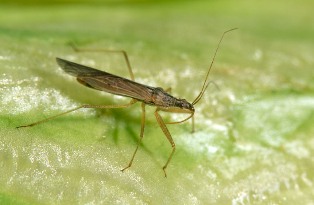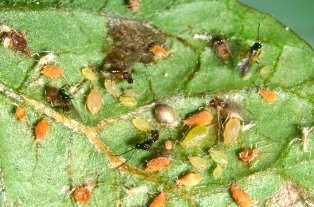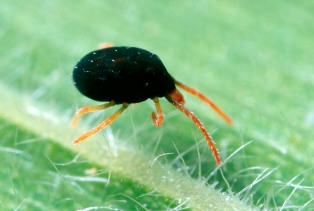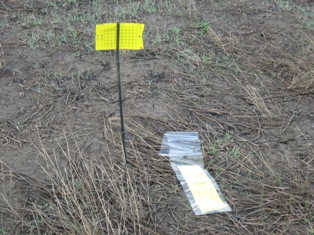IPM involves the use of biological, cultural and chemical techniques to manage pests. It offers farmers an alternative to conventional practices where chemicals are often used exclusively. While chemical control is a component of IPM strategies, it is not the primary control option, but instead a support tool. Chemicals are only used if the biological and cultural options are not sufficient to manage the pest and avoid economic loss.
The components of IPM
Biological
Using one living organism to control another. Biological controls can also be referred to as natural enemies or beneficials. Examples include: predators (eg Fig.1) and parasitoids (eg Fig. 2) that kill pest species.

Figure 1: Predator. The damsel bug (Nabis kinbergii) eats
caterpillars, aphids and other soft-bodied insect pests.

Figure 2: Parasitoid. This parasitic wasp (Aphidius species) (beneficial) lays eggs inside the bodies of aphids (pest). The immature stage develops inside the aphid eventually killing it.
Cultural
Management activities which can be used to make the environment less favourable for pest species. Examples include: timing of planting (eg planting canola (Brassica napus) early to avoid pests like slugs and earwigs, and cereals late, to lessen the threat of barley yellow dwarf virus (BYDW)); selecting resistant varieties (eg aphid resistant lucerne (Medicago sativa) and genetically modified insect resistant cotton (Gossypium species)); planting trap crops (eg Fig. 3) and weed management (eg Fig. 4).

Figure 3: Cereal strips are planted in lettuce
(Lactuca sativa) crops during spring to enhance the
biological control of aphids (pest). This technique is often
referred to as a trap crop or intercropping. The cereal
strips attract cereal aphids (which don’t eat lettuce) and
their presence encourages aphid predators. Once in the
crop the predators not only eat the cereal aphids, but any
aphid species present in the lettuce too.

Figure 4: Populations of redlegged earth mite (RLEM)
(Halotydeus destructor) (pest) can be suppressed if
capeweed (Arctheca calendula) is controlled the year prior
to a susceptible crop being planted.
Chemical
The aim is to select products that are compatible with the biological and cultural techniques, and which will effectively eradicate the pest but will cause least harm to the beneficials. Generally, selective (otherwise known as narrow-spectrum) insecticides are preferred over broad-spectrum because they target specific insect pests. For some insect pests selective insecticides are not available, so in this instance, a broad-spectrum insecticide that leaves the lowest amount of residue (trace of chemical) is preferred. While the initial application will kill all the pests and beneficials present, because there are no (or low) residual effects after it is applied, the beneficials will be able to re-establish quickly.
Consideration also needs to be given to which fungicides and herbicides are applied (to control diseases and weeds) as these too can have undesirable effects on insects.
Why use IPM instead of a pesticide-based strategy?
- Delay development of insecticide resistance (the point where chemicals lose their effectiveness against pests)
- Reduce pesticide use and residue levels on produce
- Improve worker safety
- Decrease harm to non-target organisms
- Diminish outbreaks of secondary pests (minor pests that become major as a result of pesticide use)
- Reduce environmental contamination
- Lessen spray drift onto neighbouring properties
- Reduce costs
- Improve pest control, plant health and productivity
IPM success stories
It is early days for IPM in Australian agriculture, but it has already been used with success in crops (such as canola (B. napus), cereals and vegetables), pastures and vineyards. IPM has been employed by Australian horticulturists for a number of years, with great results.
How can I use IPM on my small farm?
In comparison to a pesticide-based approach, IPM is quite complex initially because a detailed understanding of what is happening in your crop/pasture is required. Experienced IPM consultants can offer knowledge, assistance and advice.
Step 1) Initial assessment (on paper or spreadsheet)
a) Identify what pests are likely to pose a problem to your crop/pasture*
b) Identify what biological agents (beneficials) may be present to prey on or parasitise those pests*
c) Identify cultural options that may assist with pest management
d) Identify possible chemical support tools.
(*both a & b could be challenging if broad spectrum insecticides have been used in the past, but local knowledge should be helpful in determining potential pest and beneficial species).
Step 2) Getting started and monitoring
a) Withdraw broad-spectrum pesticide use on a paddock
b) Inspect the crop/pasture regularly. Damage is one of the first signs of pest presence. Correctly identify the cause of the damage (eg insect, chemical or environmental). This is critical to the success of your IPM strategy
c) Monitor the activity of both pests and beneficials. Many methods are available and depend on factors such as the type of insect, its life cycle and which part of the crop/pasture it inhabits (eg yellow sticky traps (Fig. 5) are designed to catch flying insects, sweep nets sample insects in the top portion of the crop/pasture, pheromone traps attract moths, and pitfall traps collect ground-dwelling insects)

Figure 5: A yellow sticky trap used for monitoring flying
insects eg aphids (pest) or brown lacewings
(Micromus tasmaniae) (beneficial). On the ground: a
sticky trap that has been removed from its stand and
sealed in plastic. It will be examined, and the insects
present will be identified and counted.
d) Record your observations, dates and seasons etc in a paddock diary or spreadsheet for future reference.
Step 3) Decision-making
a) Use the options identified in the initial assessment (step 1) and the information gathered from monitoring (step 2) to assist you to make informed decisions and implement a management plan if necessary
b) Presence of a pest doesn’t always signify a problem. To determine if action is necessary, the loss in revenue from the pest damage/presence often needs to be weighed up against the cost of treatment to prevent it (ie economic thresholds).
Want To Know More About Beneficials?
Follow the link: Good Bugs for Small Farms – A Beginner’s Guide
Glossary
- Beneficials: Invertebrates (animals without a backbone, ie insects) that kill pest species.
- Insecticide: Product used to control insects.
- Parasitoid: An insect that lives in, or feeds on, another insect host for a period of time eventually killing it.
- Pest: A living organism that is present where it is not wanted.
- Pesticide: Product used to control a pest (includes fungicides, herbicides and insecticides).
- Predator: An organism that preys on another and usually kills it quickly.
Acknowledgements
Many thanks to Paul Horne and Jessica Page from IPM Technologies for their support. The images in this article were kindly supplied by IPM Technologies and Denis Crawford of Graphic Science.
Author: Dr Melanie Haines (Entomologist)



